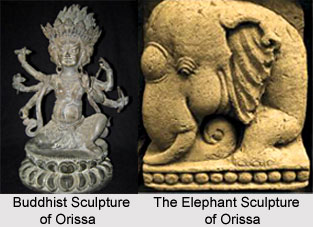 Sculpture of Orissa is evident in various temples like the temples of Lingaraj and Konark. The oldest nearly 6th or early 7th centuries, are possibly the three tiny parallel shrines of the shatrughaneshwar temple group. Two distinguishing facets can be realized - the eight, not nine, grahas (planets) in relief on the lintel of one of the sanctum doors, and the group of narrative or mythological scenes between the haifa, the wall area of the shrine and the shikhara.
Sculpture of Orissa is evident in various temples like the temples of Lingaraj and Konark. The oldest nearly 6th or early 7th centuries, are possibly the three tiny parallel shrines of the shatrughaneshwar temple group. Two distinguishing facets can be realized - the eight, not nine, grahas (planets) in relief on the lintel of one of the sanctum doors, and the group of narrative or mythological scenes between the haifa, the wall area of the shrine and the shikhara.
The Parasuramesvara temple is the best known of the earliest Orissa temples. The carving of reasonably huge images, straightaway on the walls, carrying over from one block of masonry to another is remarkable. The rows of figurines, and the pretty seldom depicted Chandra, seated between preposterously short pilasters, are squeezed by the soaring architrave above, its outsize gavasakas and figures not a great deal humbler than those beneath. Such imbalance is linked with folk art.
Walls, entryways, recesses and windows are ornamented with gavasakas, pilasters with vase and foliation capitals (and bases), birds on the lower boundaries of eaves-mouldings, chequer designs, fan-palm bands, rosettes, indeed roughly the whole repertory of post-Gupta architectural ornamentation. The lintels, however, incline to carry narrative or mythological scenes as a substitute of beam-ends carved with lion masks, and the mouldings of the doorjambs are not carried across them. The local folk spirit is predominantly strong here.
Three of the earliest temples at Bhubaneshwar- the Parasuramesvara, the Svarnajalesvara, and the Gauri-Sailkara, have stylistic feature rather than the standard pot forms. There is textual proof for these `air lingas` as the topmost members of shikharas. Other early temples comprise the Mohini, the tiny Paschimesvara, and the Uttaresvara. The Mohini possesses its absolute complement of piiriva devatiis- accessory deities- in the main recesses of the deul. The Uttaresvara, nearly all its details plastered over in the course of reinstatement, stands in its own compound alongside the Bindusarowar, with tiny shrines and a small tank. The recess sculptures, tall trim figurines with remarkably small heads, are strikingly dissimilar from those of the other early temples, and one authority believes that they were initially established somewhere else.
 The immense grandeur of the Madhukesvara complex lies however in its abundant sculpture- excellent vegetative scrolls on entryways, and the murtis on the exterior walls of the front hall. Although a certain folk element prevails, Gupta reverberations are clearer than in the early Bhubaneshwar temples. The flamboyance and absolute extravagance of the carving, undoubtedly abetted by the soft khondalite of which the temple is erected, is of the very spirit of post-Gupta style.
The immense grandeur of the Madhukesvara complex lies however in its abundant sculpture- excellent vegetative scrolls on entryways, and the murtis on the exterior walls of the front hall. Although a certain folk element prevails, Gupta reverberations are clearer than in the early Bhubaneshwar temples. The flamboyance and absolute extravagance of the carving, undoubtedly abetted by the soft khondalite of which the temple is erected, is of the very spirit of post-Gupta style.
At Sisiresvara, like in Parasuramsvara, the openings have straight crossbars of the Gupta style, but richly carved and varied with kapotas. In their truthful attachment to the grille, along with its reverberations of the ancient vedika, these Orissa jalas are in discernible disparity to the more varied and twisting designs in contemporary style. Gone is the confusion of the exterior walls of the Parasuramesvara mukhasala, with its too short pilasters. The embellishment of the exterior of the Siilganatha hall is even more intricate, skillfully orchestrated, in much deeper relief. An exquisite carved band of scenes from the Ramayana runs along the base of the roof.
The Vaital deul, one of the most attractive of all Orissa temples, is in the same compound as the Sisiresvara, to which it is related in style. It is khakhara, with a rectangular sanctum. On the coronating sala is a row of three amalakas, each with a jar-shaped finial. For once the name of the temple (Vaital, having to do with vetalas, ghosts, demons, goblins, etc) straightaway corresponds to a khakhara type, named in one of the texts, which writes that Vaitala temples are for tantric (Kaula) worship of the Mothers, who undeniably occupy the sanctum. The remaining images- and the Vaital deul is unequalled in Orissa in having figurines carved on the inside walls of the garbhagriha- include some predominantly morbid illustrations of Bhairava, the dreadful form of Shiva, abounding in cut-off heads, cups for blood-drinking and corpses, all indicating towards human sacrifice.
Shaivism, which was to dominate Orissa until at least the 13th century, dictates the iconography of the early temples. Ekapas, the one legged Shaivite image, was abnormally popular in Orissa. In the earliest sculpture there is a substantial folk element- figurines are crouched, and when (as commonly) they are seated, the legs are principally inept. Later, as at Khiching, they become classier, incorporating much of the post-Gupta aesthetic, and haloes tend to vanish.
The three hills of Ratnagiri, Lalitagiri and Udayagiri northeast of Cuttack, hold crucial Buddhist ruins. In Ratnagiri vigilant excavation by the Archaeological Survey has uncovered a large stupa and two viharas, of which the first- Monastery I, is the supreme in terms of carved stone adornment to have survived in India.



